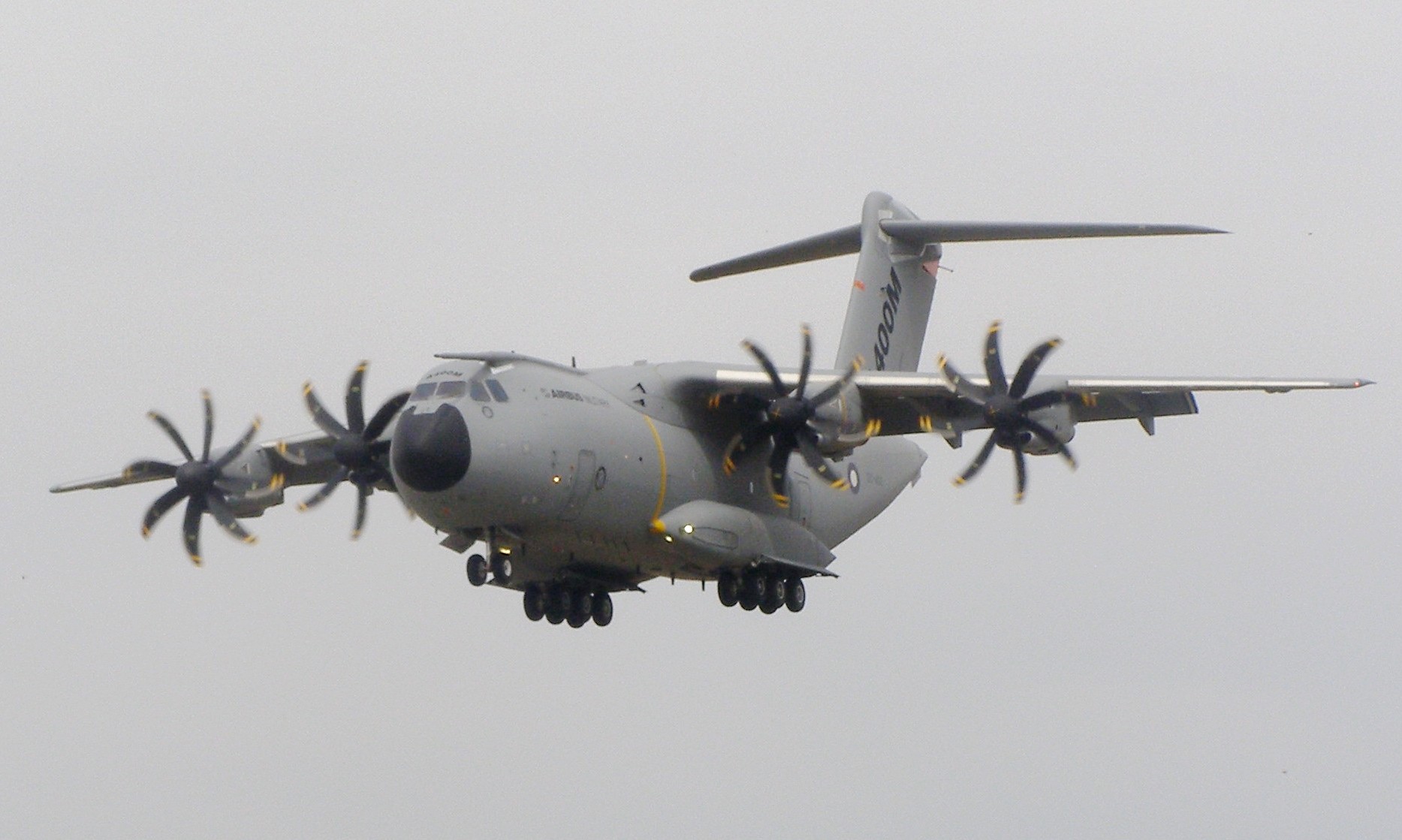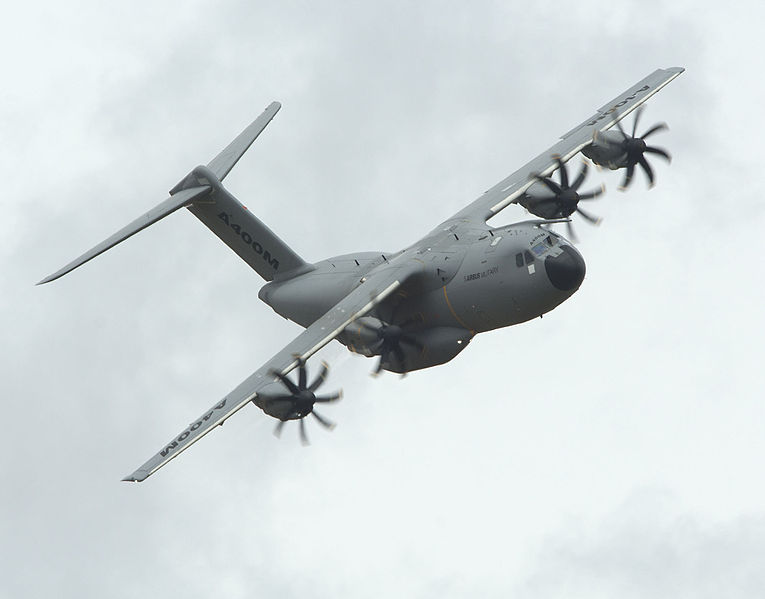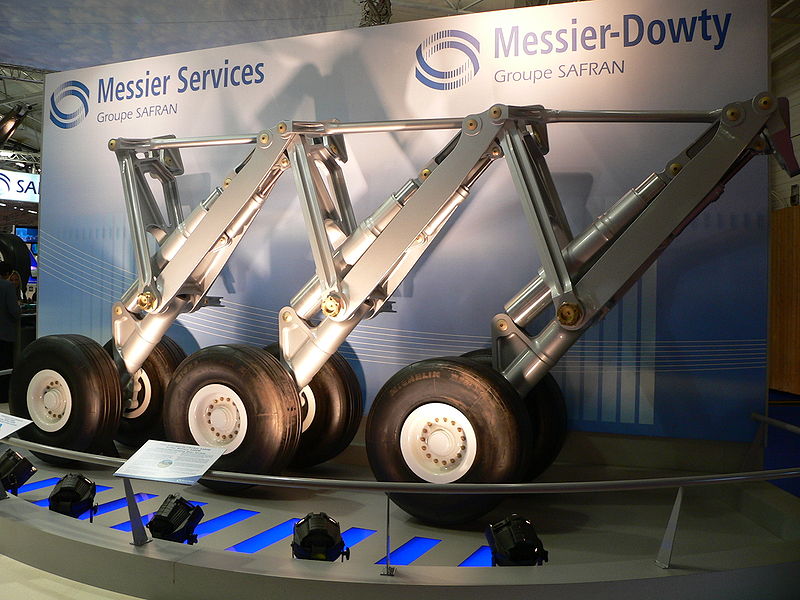A400M | |
|---|---|
| The second prototype A400M, Grizzly 2, at the 2010 Farnborough Airshow | |
| Role | Long-range military transport |
| Manufacturer | Airbus Military |
| First flight | 11 December 2009[1] |
| Status | Under development, in flight testing |
| Primary users | German Air Force (planned) French Air Force (planned) Spanish Air Force (planned) See Operators below for other users |
| Number built | 4 as of December 2010[2] |
| Unit cost | approx. €136 million[3][4] |
The Airbus A400M, also known as the Atlas,[5] is a multi-national four-engine turboprop military transport aircraft. It was designed by Airbus Military as a tactical airlifter with strategic capabilities.[6] The aircraft's maiden flight, originally planned for 2008, took place on 11 December 2009 in Seville, Spain.[1]
The A400M is undergoing flight testing. Orders totaled 174 aircraft from eight nations as of July 2011.[7] Airbus Military is expected to deliver the first aircraft in early 2013.[8]
Origins
The project began as the Future International Military Airlifter (FIMA) group, set up in 1982 by Aérospatiale, British Aerospace (BAe), Lockheed, and Messerschmitt-Bölkow-Blohm (MBB) to develop a replacement for the C-130 Hercules and Transall C-160.[9] Varying requirements and the complications of international politics caused slow progress. In 1989 Lockheed left the grouping and went on to develop an upgraded Hercules, the C-130J Super Hercules. With the addition of Alenia of Italy and CASA of Spain the FIMA group became Euroflag.
The A400M is positioned as an intermediate size between the Lockheed C-130, and the Boeing C-17. Originally the SNECMA M138 turboprop (based on the M88 core) was selected to power the A400M. Airbus Military issued a new request for proposal (RFP) in April 2002, after which Pratt & Whitney Canada with the PW180 and Europrop International answered; the latter was a new design. Airbus Military preferred the PWC engine, but political interference resulted in the selection of the Europrop TP400-D6 in May 2003.[10]
The partner nations – France, Germany, Italy, Spain, the United Kingdom, Turkey, Belgium, and Luxembourg – signed an agreement in May 2003 to buy 212 aircraft.[citation needed] These nations decided to charge the Organisation for Joint Armament Cooperation (OCCAR) with the management of the acquisition of the A400M.
Following the withdrawal of Italy and revision of procurement totals the revised requirement was for 180 aircraft, with first flight in 2008 and first delivery in 2009. On 28 April 2005, South Africa joined the partnership programme with the state-owned Denel Saab Aerostructures receiving a contract for fuselage components.
Into production
The A400M assembly at the Seville plant of EADS Spain started in the first quarter of 2007. Airbus plans to manufacture thirty aircraft per year.[11] The major assemblies arrive by Airbus Beluga transporters. The four Europrop TP400-D6 flight test engines were delivered in late February 2008 for the first A400M.[12] Static structural testing of a A400M test airframe began on 12 March 2008 in Spain.[13]
The first flight, originally scheduled for the first quarter of 2008, was postponed due to program delays, schedule adjustments and financial pressures. EADS announced in early January 2008 that continued development problems with the engines had resulted in a delay to the second quarter of 2008 before the first engine test flights on a C-130 testbed aircraft. The first flight of the aircraft, previously scheduled for July 2008, had again been postponed. Civil certification under European Aviation Safety Agency (EASA) CS-25 will be followed later by certification for military purposes. The A400M was "rolled out" in Seville on 26 June 2008 at an event presided by King Juan Carlos I of Spain.[14] On 12 January 2011, serial production of the A400M for its first customers started.[15]
Further sales
In December 2004, South Africa announced it would purchase eight A400Ms at a total cost of approximately €800 million, with the nation joining the Airbus Military team as an industrial partner. Deliveries were expected from 2010 to 2012.[16][17]
In July 2005, the Chilean Air Force signed a Memorandum of understanding for three aircraft,[18] but no order has been placed.[19] In December 2005, the Royal Malaysian Air Force ordered four A400Ms to supplement its fleet of Lockheed C-130 Hercules.[20][21]
Airbus Military made a bid in 2006 to supply Canada with the A400M to meet a tender request for 17 new tactical airlifters to replace their old C-130E models.[22] The Canadians ordered four C-17 Globemaster IIIs and 17 C-130J Super Hercules instead.[23]
In 2009 the United States Air Force Air Mobility Command requested information on the A400M and the company responded with a proposal for 118 A400Ms.[24] In June 2010, EADS suggested a possibility that the Royal Australian Air Force might consider buying the A400M.[25] |
| A400M flying during the Royal International Air Tattoo (RIAT) 2010 |
Development problems
On 9 January 2009, EADS announced that the first delivery has been postponed until at least 2012. EADS also indicated that it wanted to renegotiate "certain technical characteristics" of the aircraft.[26] EADS has long maintained the first deliveries would begin three years after the A400M's first flight. The German newspaper Financial Times Deutschland has closely followed the A400M program and reported on 12 January 2009 that the aircraft is overweight by 12 tons and may not be able to achieve a critical performance requirement, the ability to airlift 32 tons. Sources told FTD at the time that the aircraft could only lift 29 tons, which is insufficient to carry a modern armored infantry fighting vehicle (like the Puma).[27] The FTD report prompted the chief of the German Air Force to say, "That is a disastrous development," and could delay deliveries to the Luftwaffe until 2014.[28] The Initial Operational Capability (IOC) for the Luftwaffe is delayed at least until 2017. This leads the political planning to potential alternatives in the shape of a higher integration of European airlift capabilities.[29] The OCCAR reminded the participating countries that they can terminate the contract before 31 March 2009.[30]
On 29 March 2009, Airbus CEO Thomas Enders told Der Spiegel magazine that the program may need to be abandoned without changes.[31] Then on 3 April 2009 the South African Air Force announced that it would start considering alternatives to the A400M due to postponed production and increased cost.[32] On 5 November 2009, South Africa announced it was cancelling the order citing increased cost and delivery delays.[33] On 12 June, The New York Times reported that Germany and France have delayed the decision whether or not to cancel their orders for another six months, while the UK still plans to decide at the end of June. The NYT also quotes a report to the French Senate from February 2009, according to which "the A400M is €5 billion over budget, 3 to 4 years behind schedule, [...] aerospace experts estimate it is also costing Airbus between €1 billion and €1.5 billion a year."[34]
The shortage of military transports caused by the A400M delay forced the UK to lease, and subsequently purchase, six C-17s. France and Germany have also been considering other planes, as all three countries need to support their operations in Afghanistan.[35] The ADS Group has warned that shifting the British orders to American aircraft for the short term budget savings would cost much more over time in missed civil and military aerospace business, because they say that the technologies used in the A400M would be a bridge to the next generation of civilian aircraft.[36] In June 2009, Lockheed Martin said that both United Kingdom and France had asked for technical details on the C-130J as an alternative to the A400M.[37]
Airbus acknowledged in 2009 that the program is expected to lose at least €2.4 billion and cannot break even without sales outside NATO countries.[10] A PricewaterhouseCoopers audit of the program projected that it would run €11.2 billion over budget unless corrective measures were taken, which would result in an overrun of only €7.6 billion.[38] On 24 July 2009, the seven European nations announced that they would continue with the A400M program, and form a joint procurement agency to renegotiate the contract with EADS.[39][40] The ministers of the seven European launch customers were supposed to meet 15 October 2009 in Germany to approve a new timetable, configuration and financial terms for the A400M airlifter.[41] On 14 October 2009, French Ministry of Defense spokesman Laurent Teisseire, announced this meeting had been postponed.[42] |
| The first A400M in Seville, Spain on 11 December 2009, before its maiden flight |
On 9 December 2009, the Financial Times reported that Airbus has asked for an additional €5 billion subsidy to complete the project.[43] On 5 January 2010, Airbus repeated that the A400M program may be scrapped, costing Airbus €5.7 billion unless €5.3 billion was added by partner governments.[44] On 11 January 2010, Tom Enders, Airbus chief executive, stated that he was prepared to cancel production of the A400M if European governments did not provide more funding. Delays to the A400M project had already increased its budget by 25%.[45]
On 5 November 2010, Belgium, Britain, France, Germany, Luxembourg, Spain and Turkey finalised the contract and agreed to lend Airbus Military €1.5 billion. The program is at least three years behind schedule. The deal, however, meant also that the UK reduced its order from 25 to 22 aircraft and Germany from 60 to 53, decreasing the total order from 180 to 170.[46]
Flight testing
Before the first flight, the company obtained the required hours of airborne test time on the engines using a C-130 testbed aircraft.[47][48] The first flight of the C-130 testbed occurred on 17 December 2008.[49] The A400M's maiden flight was carried out from Seville on 11 December 2009.[1] The first A400M had flown 39 hours of test flights as of 9 March 2010.[50] The second test aircraft's engines were tested on 18 March 2010 prior to it beginning test flights.[51] The second A400M completed its first flight on 8 April 2010.[52] The third A400M took to the air in July 2010. With this flight the three A400Ms have taken more than 100 flights, totaling 400 hours.[53]
In July 2010, the A400M passed a key test: ultimate-load testing of the wing.[54] On 28 October 2010, Airbus Military announced that it was about to start refuelling and air-drop tests.[55] By late October 2010 the A400M had flown 672 hours of the 2,700 hours expected to reach certification. Cold weather testing is to be performed in either Canada or Sweden.[56] In November 2010, the first paratroop jumps were performed from the A400M.[57] In December 2010 the A400M fleet's flight time has risen to 965 hours.[58] A400M number four joined the test fleet with its first flight of over five hours on 20 December 2010.[2]
Winter tests were done in Kiruna, Sweden during February 2011.[59] By April 2011 a total of 1,400 flight hours over 450 flights had been achieved.[60] In May 2011 the A400M's EPI TP400-D6 engine received certification from the European Aviation Safety Agency (EASA).[61] In May 2011, the A400M fleet had totaled 1,600 hours over 500 flights; by September 2011, the total increased to 2,100 hours and 684 flights.[62]
Due to a problem with the gearbox the A400M did not fly demonstrations at the 2011 Paris Air Show. It was shown on static display instead.[63]
Design
 |
The Airbus A400M will increase the airlift capacity and range compared with the aircraft it was originally set to replace, the older versions of the Hercules and Transall. Cargo capacity is expected to double over existing aircraft, both in payload and volume, and range is increased substantially as well. The cargo box is 17.71 m long excluding ramp, 4.00 m wide, and 3.85 m high. The height is 4.00 m aft of the wing and the ramp is 5.40 m long.
The A400M will operate in many configurations including cargo transport, troop transport, Medical evacuation, aerial refuelling, and electronic surveillance.[citation needed] The aircraft is intended for use on short, soft landing strips and for long-range, cargo transport flights.[64]
It features a fly-by-wire flight control system with sidestick controllers and flight envelope protection. Like other Airbus aircraft, the A400M will have a full glass cockpit (all information accessed through large colour screens) and as such will represent a technological leap compared to the older C-130s and C-160s that many countries now operate.
 |
The A400M's wings are primarily carbon fibre reinforced plastic. The eight-bladed Scimitar propeller is also made from a woven composite material. The aircraft is powered by four Europrop TP400-D6 engines rated at 8,250 kW (11,000 hp) each.[65] The TP400-D6 engine is to be the most powerful turboprop engine in the West to enter operational use.[61] One of the few propeller powered aircraft with swept wings, the turboprops provide an efficient cruise speed of 780 km/h (480 mph) which falls between the C-130 and the jet-powered C-17.
The propellers on each wing of the A400M turn in opposite directions, with the tips of the propellers advancing from above towards the midpoint between the two engines. This is in contrast to the overwhelming majority of multi-engine propeller driven aircraft where all propellers on the same wing turn in the same direction. The counter-rotation is achieved by the use of a gearbox fitted to two of the engines, and only the propeller turns the opposite direction; all four engines are identical and turn in the same direction which eliminates the need to have two different "handed" engines on stock for the same aircraft, which simplifies maintenance and supply costs. This configuration, dubbed DBE (Down Between Engines), allows the aircraft to produce more lift and lessens the torque and prop wash on each wing. It also reduces yaw in the event of an outboard engine failure.[66]
EADS and Thales will provide the new Multi-Colour Infrared Alerting Sensor (MIRAS) missile warning sensor for the A400M.[67][68] |
| A400M showing its counter-rotating propellers |
Orders
| Date | Country | Orders | Entry into service date | Notes |
|---|---|---|---|---|
| 27 May 2003 | 53 | Unknown | Order reduced from 60 to 53,[69] and will try to resell 13, leaving 40.[70] | |
| 50 | Expected 2013 | |||
| 27 | Unknown | |||
| 22 | Unknown | Order reduced from 25[71] | ||
| 10 | Expected 2013 | Last of the 10 A400M expected to be delivered in 2018 [72] | ||
| 7 | Expected 2018/20 | |||
| 1 | Unknown | |||
| 8 December 2005 | 4[20] | 2015 | ||
| Total: | 174 |
 |
Specifications
 |
Data from Airbus Military specifications[73]
General characteristics
- Crew: 3 or 4 (2 pilots, 3rd optional, 1 loadmaster)
- Capacity: 37,000 kg (81,600 lb)
- 116 fully equipped troops / paratroops,
- up to 66 stretchers accompanied by 25 medical personnel
- Length: 45.1 m (148 ft 0 in)
- Wingspan: 42.4 m (139 ft 1 in)
- Height: 14.7 m (48 ft 3 in)
- Empty weight: 76,500 kg (168,654 lb) ; operating weight[74]
- Max takeoff weight: 141,000 kg (310,852 lb)
- Fuel capacity: 50,500 kg (111,330 lb) internal fuel
- Max landing weight: 122,000 kg (268,963 lb)
- Powerplant: 4 × Europrop TP400-D6[75] turboprop, 8,250 kW (11,060 hp) each
- Propellers: 8-bladed, 5.3 m (17 ft 5 in) diameter
Performance
- Cruising speed: 780 km/h (480 mph; 420 kn) (Mach 0.68-0.72)
- Initial cruise altitude: at MTOW: 9,000 m (29,000 ft)
- Range: 3,298 km (2,049 mi; 1,781 nmi) at max payload (long range cruise speed; reserves as per MIL-C-5011A)
- Range at 30-tonne payload: 4,540 km (2,450 nmi)
- Range at 20-tonne payload: 6,390 km (3,450 nmi)
- Ferry range: 8,710 km (5,412 mi; 4,703 nmi)
- Service ceiling: 11,300 m (37,073 ft)
- Tactical takeoff distance: 980 m (3,215 ft) (aircraft weight 100 tonnes, soft field, ISA, sea level)
- Tactical landing distance: 770 m (2,526 ft) (as above)
- Turning radius (ground): 28.6 m

0 comments:
Post a Comment